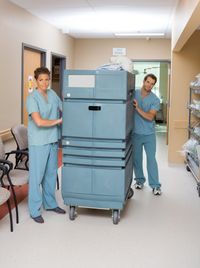A Guide for Selecting the Right Caster & Wheels

Business owners understand the crucial role that casters and wheels play in creating efficient handling systems and safely transporting materials on their premises. While, in general, all casters all serve the same purpose, some types of casters are made to perform better than others. Some are designed to carry heavier loads while others can move efficiently on a wide range of flooring conditions. Here’s a brief guide to help you get started.
What Are Casters?
Often confused with wheels, a caster includes a mounting system or bracket to hold the wheel in place. Casters are typically attached underneath equipment or furniture to allow faster movement and easier handling of heavy materials. They come in two main varieties — rigid and swivel. Rigid casters are fixed in place and can only move in one straight path. Swivel casters, on the other hand, have revolving mounts that allow full rotation and steering in any direction. Some casters have locking mechanisms that restrict movement. Since caster wheels can be made from plastic, metal, rubber, and polyurethane, they come in different sizes and hardness as well.
Why Use Casters
Because of their functionality and durability, casters and wheels are used in nearly every industry — and even in your home. They are often installed in sets of two or four for stability and easy maneuverability. Among the key benefit of using casters is increased mobility, making it simpler to move hefty load or machinery around the premises. It also aids in streamlining the production process, as it speeds up material handling and storage. Since casters and wheels provide assistance to personnel, they reduce physical strain associated with moving fairly large loads from one point to another.
How to Choose Right
 Before purchasing casters and wheels, figure out your requirements and possible application first to make them last longer; and, avoid serious injuries in the process. Consult with an expert to determine what design and materials are ideal with your proposed use.
Before purchasing casters and wheels, figure out your requirements and possible application first to make them last longer; and, avoid serious injuries in the process. Consult with an expert to determine what design and materials are ideal with your proposed use.
Your considerations on what to select should include floor conditions, load capacity of maximum weight, frequency of use, operating environment, and restrictions on speed and noise. If you need to transport hefty loads, go with larger caster wheels for even weight distribution and easier movement. Check extraordinary conditions — such as severe temperature shifts, humidity, and corrosive chemicals — prevalent in the working environment to choose the ideal wheel material. Consider safety features like locks when used in the medical or food industry.
There is no one-size-fits-all solution for casters and wheels. To choose the right type, you’ll need to decide on their use beforehand. Let the professionals at Casters, Wheels and Industrial Handling of Nassau County, NY, assist you in finding quality casters from top industrial brands. They offer an impressive selection of light- and heavy-duty casters for various applications. Call (631) 650-0500 or visit their website to learn more.
About the Business
Have a question? Ask the experts!
Send your question

